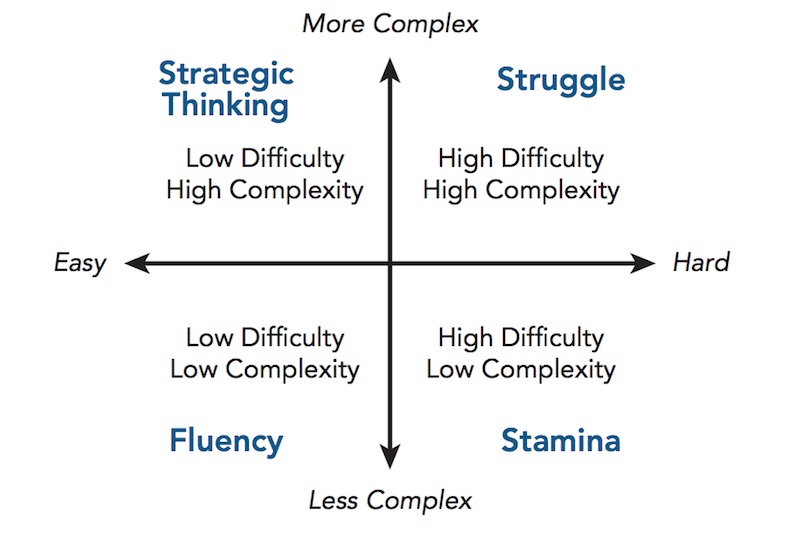While there is a great deal in the literature about helping struggling students and providing interventions for everything from physical to learning disabilities, there is relatively little on the topic of engaging students effectively. But what does engagement mean? Does it mean simply keeping the students awake enough in the classroom to absorb some of the material? Does it mean teachers should be entertaining to create focus? Does it mean students should display outward behavioral characteristics like leaning forward in their seats or maintaining eye contact with the teacher during the class? Certainly all of these are of some value, but they are all more like a bag of tricks designed to hold attention than things that truly challenge students in any way.
Douglas Fisher and Nancy Frey argue in a “We are Teachers” blog post that engagement occurs when three specific conditions are present: 1) positive student-teacher relationships; 2) clarity in instruction; and 3) challenge.[1] Firstly, students are more willing and able to take on challenging tasks when they have a strong, positive relationship with their teacher. Secondly, the students have a better understanding of how to meet challenges when the teacher is clear about the learning intentions and success criteria. Thirdly, the task itself must provide a challenge. The problem, the authors comment, is that “challenge” is often confused with “difficulty,” and that should not be the case; the goal in this case should be the complexity of the task.
Difficulty can be described as a measure of the amount of effort, work, or time necessary to complete a task. Complexity, however, is the type of thinking, the number of steps, or the necessary background knowledge required for that task. As an example, take memorizing a long string of unrelated numbers. The task is certainly difficult, but it is in no way complex. It is a simple case of rote memorization and later recall. This is true, as well, if the student is given 10 mathematics problems to solve using a particular formula or 50 using the same one; the latter takes more time, but it does not require any additional thinking from the student.
The authors use the following graph to describe how tasks can be divided along difficulty and complexity lines:

Because both fluency and stamina fall on the low end of the complexity axis, tasks in these categories are relatively easy to complete and ones that the students can work on independently. On the other hand, both strategic thinking and the struggle to build expertise rank on the high end of the complexity scale, and tasks in these categories are best accomplished by working together with peers and the teacher. Students should be exposed to all of these task types in their studies to help them become proficient in the subject matter being taught.[1]
Let’s take a further look into the four task types.
- Fluency. Also known as automaticity, fluency is essential for learning. Fluency includes mastery of such things as sight words or mathematical/scientific equations, which allows space for the brain to engage in more complex thinking. Fluency level and mastery of conceptual material should increase in difficulty with the age/grade of the student.
- Stamina. Also known as perseverance, or more commonly, “grit,” stamina allows the student to engage in an educational task for increasingly longer periods of time. Reading lengthier texts, studying for an upcoming summative assessment, and writing a long-term research paper are just three ways in which stamina contributes to learning. While the tasks the students engage in are more difficult than they previously encountered and require a lot of self-regulation, they are still relatively non-complex tasks. Regular experiences with such activities help students discover their current and growing capacity to persist.
- Strategic planning. Strategic planning tasks often require metacognitive thinking, such as setting goals, making a plan, and adjusting the plan based on progress or lack thereof. In the early stages of planning, student teams make decisions about how they will approach the task, both together and individually, what internal timelines they will create to stay on track, and how they will use a rubric or checklist to make sure they are fulfilling the project’s requirements. Because this is a more complex task, input and guidance from the teacher are critical for success.
- Struggle for expertise. Struggle tasks are both highly difficult and highly complex; they draw on students’ fluency, stamina, and strategic thinking to complete them successfully. Because they are so demanding, the teacher must serve as a guide and as a helper. As an example, let’s use a close and critical reading of a complex text. The teacher asks text-dependent questions that move students through four stages of thinking (Frey & Fisher, 2013):
- What does the text say? (Literal level of meaning)
- How does the text work? (Structural level of meaning)
- What does the text mean? (Inferential level of meaning)
- What does the text inspire you to do? (Interpretive level of meaning)
When they reach the interpretive level, students engage in additional critical analysis through essays, debates, or other analytic devices.[2]
All of these different types of tasks are important, and learning occurs when students stretch to reach a new goal. If the challenge is too great, instead of generating struggle, we cause the students to give up. If the challenge doesn’t exist, they become bored and tune out. However, when a challenge is matched with both positive relationships and clarity, we create the conditions necessary for learning. That is the ultimate form of student engagement.
Citations:
[1] Fisher, Douglas, and Frey, Nancy. (October 17, 2017). “In Order to Challenge Students, We Need to Go Beyond Grit.” Retrieved from: https://www.weareteachers.com/challenge-students-engagment/?utm_campaign=Corwin_1708_ART+FOUR&utm_medium=social&utm_source=Social&utm_content=1508345235
[2] Frey and Fisher (2013), as described in Fisher, Douglas, and Frey, Nancy. (October 17, 2017). “In Order to Challenge Students, We Need to Go Beyond Grit.” Retrieved from: https://www.weareteachers.com/challenge-students-engagment/?utm_campaign=Corwin_1708_ART+FOUR&utm_medium=social&utm_source=Social&utm_content=1508345235

1 thought on “How to Challenge Students Effectively”